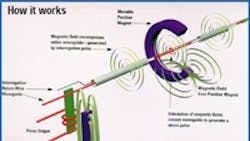MSD 101: Magnetostrictive position sensors
The tendency of certain materials to deform in a magnetic field is the working principle behind many industrial devices, including magnetostrictive position sensors. Here, magnetostriction occurs along a ferromagnetic wire, or waveguide, that passes through a ring-shaped magnet serving to indicate position.
The actual measurement process is somewhat involved, but it produces repeatable, accurate results. First, a flash of current shoots through the wire, creating a column of magnetic flux that reacts with the localized field of the permanent magnet. The brief meeting between the two magnetic fields induces a torque on the wire, causing it to twist at the point where the fields intersect. The twist then propagates in both directions, traveling at a sonic rate of about 3.55 μsec/cm. The time it takes the strain pulse to reach the end of the waveguide gives an accurate measure of the magnet’s position.
What happens next centers on the action of a cantilever beam welded to the waveguide. The beam, which extends through the hollow of a pickup coil, deflects in the direction of the strain pulse, rerouting the flux of a nearby bias magnet. The coil senses this variation, producing a current pulse in response. The actual output depends on interface electronics and can be anything from a pulse-width-modulated position signal to an analog waveform indicating velocity.
Questions & answers
Q: What is the typical resolution?
A: Some sensors can resolve movements as small as 2 μm with a single interrogation. In general, R = 1/GfC, where R = resolution (in.); G = gradient, the rate of strain propagation along the waveguide (about 9.0 μsec/in.); f = counter frequency (about 28 MHz); and C = circulations, the number of interrogations averaged to calculate position.
Q: How long is the sensing range?
A: Stroke lengths of up to 144 in. are easily achieved with 0.01% nonlinearity.
Q: Are these devices suited for tough jobs?
A: Many are fully encapsulated, rated IP-67. They also withstand high shock (20g) and vibration (5g) and are reasonably stable, having temperature coefficients in the range of 100 ppm/°C.
